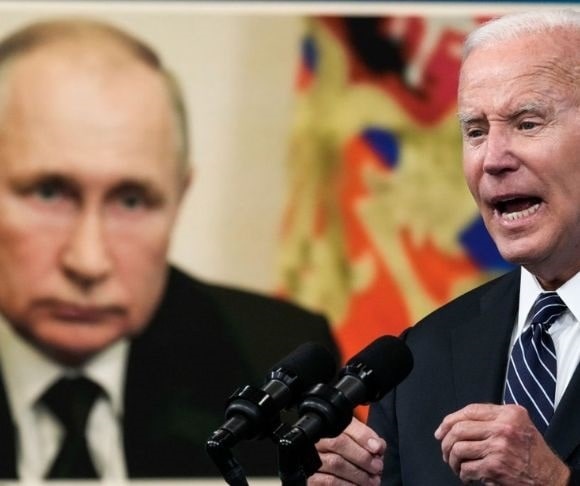
Vladimir Putin (left) and Joe Biden (right) (Photo by Drew Angerer/Getty Images)
Eschewing provocation and avoiding confrontation as national security policy is neither a sound nor sustainable Ukraine strategy. The Biden administration is quick to invoke deterrence as a bulwark against Russia, but deterrence is of no value without two critical elements: demonstrable military power and clear understanding on the part of the Kremlin that, if tested, US strength will be used. Consequently, the United States persistently justifying its actions before and during the Russian invasion of Ukraine as not wishing to appear provocative is perplexing.
After the Russians illegally annexed Crimea and invaded and occupied the Donbas region of Ukraine in 2014, the US, UK, and other NATO countries began training and equipping the Ukrainian military. However, “[T]he weapons they had supplied were primarily small-bore and defensive so that they wouldn’t be seen as a Western provocation,” a Washington, DC, newspaper reported. “I make no apologies for the fact that one of our objectives here is to avoid direct conflict with Russia,” Jake Sullivan, Biden’s national security advisor, admitted prior to the current hostilities in Ukraine, in the same Washington, DC, media outlet. But unfortunately, that is the point.
Don’t Anger Russia – America’s Ukraine Strategy
Some accounts of White House diplomatic and military outreach activities explained that General Mark Milley, chairman of the Joint Chiefs of Staff, carried with him a card reminding him his number one objective was “Don’t have a kinetic conflict between the US military and NATO with Russia.” A hot war between NATO and Moscow is not a wished-for outcome but making it the number one concern gives away the element of uncertainty for the enemy. It forecloses options where the US and NATO could prevail. Though the primary aim of Milley’s number one objective predated President Vladimir Putin’s February attack on Ukraine, Moscow now is more confident of the US position. Why would Putin not become more emboldened? In another instance of what appeared to be cowing, the excuse given for the US turning down Poland’s offer to provide the Kyiv government Soviet-era MIG-29 fighter aircraft to replace combat losses of same MIG-29 Soviet-era fighter aircraft was that it was too provocative. That was a head-scratcher for many.

Vladimir Putin (left) and Joe Biden (right) (Photo by Drew Angerer/Getty Images)
The risk aversion and reluctance to appear provocative ignore the new realities of NATO’s military capabilities compared with those of Russia. NATO is not the modest Cold War military defensive line represented by the original 12 European nations facing the formidable Soviet Union with its Warsaw Bloc allies. Few believed at the time NATO would win conventionally against the USSR with its large economy, an overwhelming number of combat-hardened troops, tanks, combat aircraft, a substantial number of nuclear submarines, and an imposing surface navy. That was the reason for the US possessing a sizeable nuclear force. But that was then, and this is now. The tables have turned. Russia has no backstop of Eastern Bloc nations. A number of those countries, having been freed from Soviet bondage, are now in NATO. Moscow’s economy is roughly that of Texas – not even in the top ten world GDPs and ranking 162 in five-year GDP growth. Furthermore, its military cache has diminished compared to the NATO alliance of 30 member nations, with Finland and Sweden soon to make that number 32.
NATO More Capable Than Russia
In a military capability face-off with NATO, Russia is overmatched in many respects. In a head-to-head comparison, NATO has a four-to-one advantage in overall military personnel, including active duty, reserve forces, and paramilitary units. When it comes to total combat aircraft, NATO’s advantage is five to one. Even in main battle tanks, where the Cold War numbers significantly favored Moscow-led forces, NATO can field 14,682 tanks compared to the Kremlin’s 12,420. In the general category of ground combat vehicles, NATO has four times the number of Russia’s armored vehicles.
 Moreover, the Rodina’s naval forces have greatly diminished. Moscow can boast only 605 military ships with one aircraft carrier and 70 submarines. The number of Russian naval vessels is reduced further, considering Ukraine recently attacked and sank several of Putin’s vessels, including the missile cruiser and Black Sea flagship Moskva. On the other hand, NATO has a fleet of 2,049 naval vessels with 17 aircraft carriers.
Moreover, the Rodina’s naval forces have greatly diminished. Moscow can boast only 605 military ships with one aircraft carrier and 70 submarines. The number of Russian naval vessels is reduced further, considering Ukraine recently attacked and sank several of Putin’s vessels, including the missile cruiser and Black Sea flagship Moskva. On the other hand, NATO has a fleet of 2,049 naval vessels with 17 aircraft carriers.
Despite the lopsided conventional capability held by NATO forces, the proverbial game-changer in the deterrence standoff is nuclear weapons. Here too, NATO, with 6,065 nuclear warheads, makes it a stalemate facing Russia’s 6,255 atomic weapons. There is no real advantage for either side, and that establishes the deterrent value of the balance in nuclear capabilities. Therefore, Putin’s periodic threats to use nuclear weapons do not have the intimidation value they once did.
NATO has substantial military capability. So, why does the US hide behind the curtain of not wanting to appear provocative? The image of risk aversion is not a viable Ukraine strategy. Weakness invites hostilities, the very situation the US is attempting to avert.
The views expressed are those of the author and not of any other affiliation.
Check out Whatfinger.com, the #1 Alternative to the Drudge


